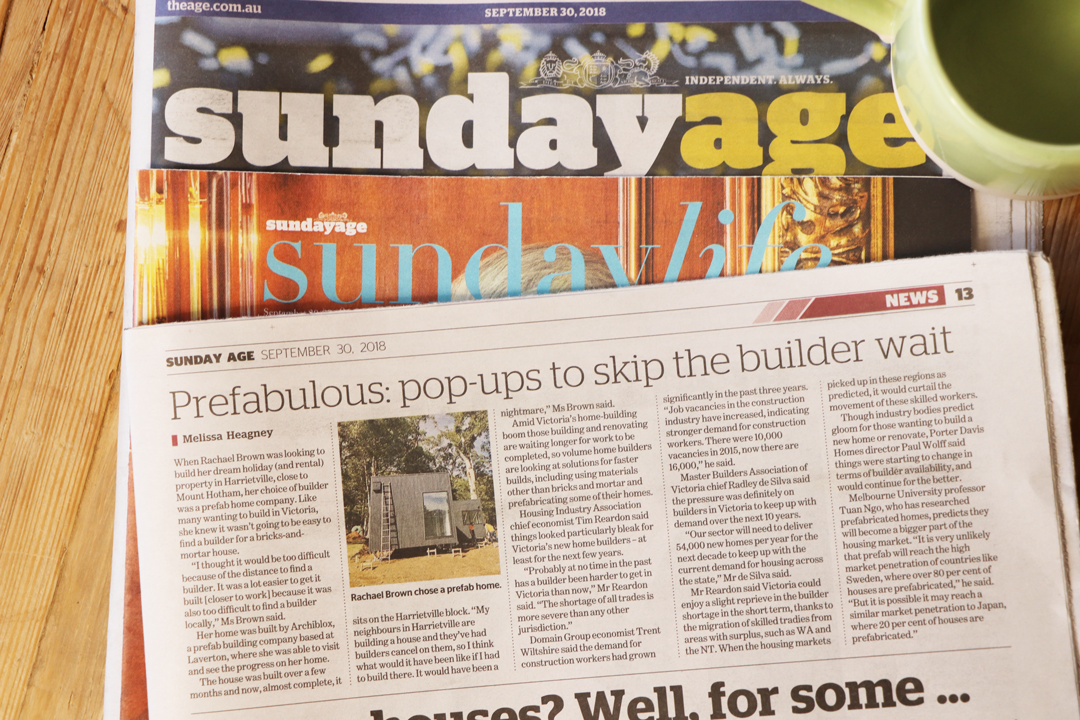08 October 2018
The Builder Shortage is Changing Victoria’s Housing Market, With a Push to Prefab
Words by Melissa Heagney for The Age – Domain.
When Rachael Brown was looking to build her dream holiday (and rental) property in Harrietville, close to Mt Hotham in Victoria, her choice of builder was a prefab home company. Like many wanting to build in Victoria, she knew it wasn’t going to be easy to find a builder for a bricks and mortar type home.
“I thought it would be too difficult because of the distance to find a builder – it was a lot easier to get it built [closer to work] because it was also too difficult to find a builder locally,” Ms Brown said.
Ms Brown’s home was built by Archiblox, a prefab building company based in Laverton, where she was able to visit and see the progress on her home. The house was built over a few short months and now, almost complete, it is sitting on the Harrietville block.

“My neighbours in Harrietville are building a house and they’ve had builders cancel on them, so I think what would it have been like if I had to build there. It would have been a nightmare,” Ms Brown said.
Amid Victoria’s home-building boom, those building and renovating are waiting longer for work to be completed, so volume home builders are now looking at solutions for faster builds. They include using materials other than bricks and mortar and prefabricating some of their home offerings.
Housing Industry Association chief economist Tim Reardon said things were looking particularly bleak for Victoria’s new home builders – at least for the next few years. “Probably at no time in the past has a builder been harder to get in Victoria than now,” Mr Reardon said. “The shortage of all trades is more severe than any other jurisdiction.”
Mr Reardon said the HIA’s Trades Report showed Western Australia and the Northern Territory were the only states and territories in Australia where trades were in surplus, following the decline of the mining boom.
Domain Group economist Trent Wiltshire said the demand for construction workers had grown significantly over the past three years. “Job vacancies in the construction industry have increased, indicating stronger demand for construction workers. There were 10,000 vacancies in 2015, now there are 16,000,” Mr Wiltshire said.

Master Builders Association of Victoria CEO Radley de Silva said the pressure was definitely on builders in Victoria to keep up with demand over the next 10 years.
“The demand for builders is intense. According to Master Builders’ report Construction Workforce in Victoria, our sector will need to deliver 54,000 new homes per year for the next decade to keep up with the current demand for housing across the state,” Mr de Silva said.
Mr Reardon said Victoria may enjoy a slight reprieve in the builder shortage over the short term thanks to the migration of skilled tradies from areas with surplus, like WA and the NT.
When the housing markets picked up in these regions as predicted, it would stop the movement of these skilled workers to build homes.
Though industry bodies predict doom and gloom for those wanting to build a new home or renovate, Porter Davis Homes director Paul Wolff said things were already starting to change in terms of builder availability, and would continue for the better in the near future. “I think it will be self correcting – we’re already seeing signs of trades availability in Victoria’s southeast volumes [builds],” he said.

Simon Mongan from the Homebuyers Centre agreed: “What we are experiencing in Melbourne is no different to what was experienced in Perth five to 10 years ago and Sydney just a few years ago. Those markets have slowed down and the supply chain has is catching up with the work. “The same will happen in Melbourne over the next few years. We as an industry need to manage our way through this period to ensure we continue to deliver affordable housing to the Melbourne market.”
Like Ms Brown, Porter Davis is looking at ways it can make a build faster and more efficient for buyers and builders. They have been building prefab homes for their upmarket boutique homes (knockdown and rebuilds) and their volume builds across Australia.
“We actually do 130 to 150 pre-finished houses per year in that space,” Mr Wolff said.

University of Melbourne professor Tuan Ngo, who has researched the building of pre-fabricated homes, predicts they will become a bigger part of the housing market. “The shortage of builders is certainly a problem, but the scale of the prefab industry is still small, therefore buyers have a limited choice,” Professor Ngo said.
“It is very unlikely that prefab will reach the high market penetration of countries like Sweden, where over 80 percent of houses are prefabricated.
“But it is possible it may reach a similar market penetration to Japan, where 20 percent of houses are prefabricated if prefab builders provide good designs, quality homes that meet market needs and use the benefits of prefab to provide a better experience in terms of customer service to the buyer.”
Original post by Melissa Heagney for Domain.
We love sharing all the new and exciting things happening at Archiblox, so make sure you’re following us on Instagram, Facebook and
Twitter, or signed up to our monthly newsletter, to ensure you don’t miss a thing.